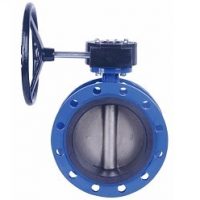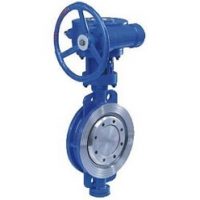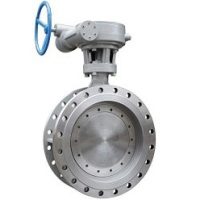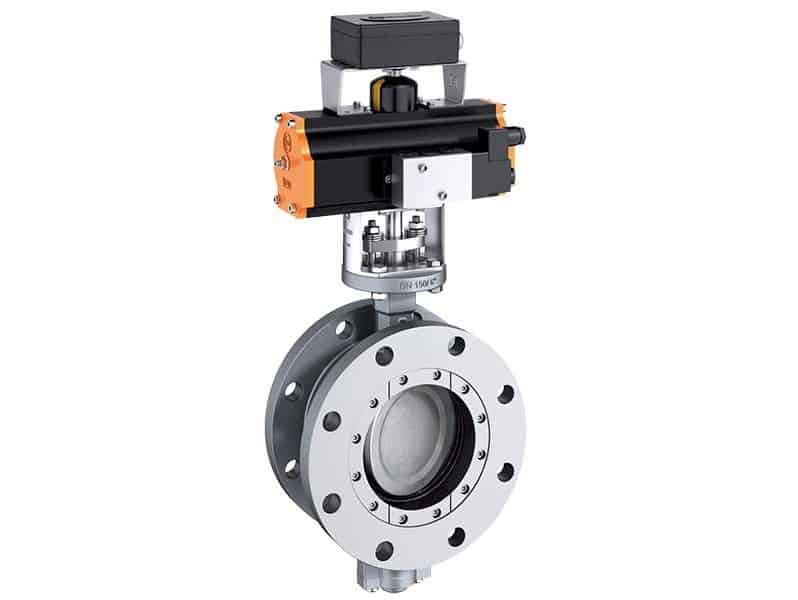Butterfly Valve
Butterfly Valve
One of the primary reasons that are driving the market’s growth is the growing tendency of automation in the oil & gas industry. Butterfly valves are widely employed in crude oil and gas extraction from distilleries, oil platforms, and depots. They’re also employed to boost the industrial production process’s operational performance. Furthermore, increased investments in clean energy with less carbon footprints in emerging nations are expected to expand the market. The rise of smart integrated cities, which has a lot more energy consumption, has boosted the use of butterfly valves even more.
Furthermore, there is an increasing need for stainless steel variations that can endure high pressure and do not require maintenance. Also due to their small size, lightweight, and cheap operating costs, they have commonly employed in paper and pulp manufacturing, fuel processing & transmission, HVAC systems.
So, in this article, let’s discuss more about the butterfly valve in detail and find out how it works, the classification of butterfly valves, advantages, disadvantages, and a wide range of their applications. We have also listed top butterfly valve manufacturers in the world at the end.
REQUEST A QUOTE FOR MORE DETAILS
What is a Butterfly Valve?
The butterfly valve is a rotational valve that swiftly opens or closes the flow passage that rotates a disc-shaped seating by making a quarter turn or a 90-degree turn. The flow is controlled in butterfly valves by a disc-type element held in position in the middle of the valve by a rod. Butterfly valves are recognized for their simple construction, lightweight, and compact shape, making them ideal for usage in confined spaces. Because of their compact face-to-face dimensions, butterfly valves have a far less pressure drop than globe valves. The length to diameter ratio of butterfly valve is approximately one-third that of a gate valve.
The butterfly valve was designed to be utilized in situations where a tight seal was not desired. However, over time, butterfly valves have been created with pretty tight seals that are made from rubber or elastomeric substances that give good sealing, as compared to other kinds of valves. Butterfly valves can also be employed for throttling or controlling flow with being completely open or fully closed, which is very useful when large-size valves with motorized actuation are required.
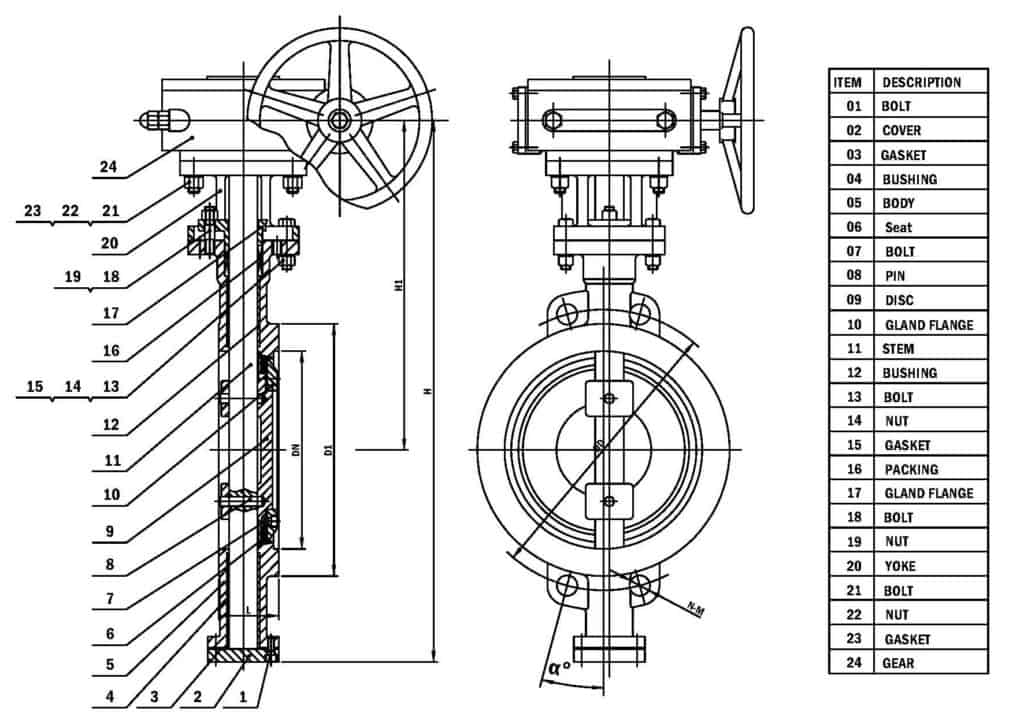
Compared to plug and ball valves, they are smaller and lighter. They can be operated using a hand wheel, a wrench, or a gearing system.
Working Principle: Butterfly Valve
While operating the butterfly valve the disc is turned a quarter turn, the valve opens entirely or closes completely. The operating mechanism of a butterfly valve is based on a flat, circular plate called “the butterfly” that is positioned in the middle of the pipe. A rod is drilled through centre of the disc and connected to an actuator on the valve’s exterior at the top. When the operator of the butterfly valve is rotated, the plate is positioned either parallel or at right angles to the fluid flow. Unlike a ball valve, the plate is always available inside the flow, causing a pressure drop in the flow regardless of the valve’s orientation.
A metal disc is connected to a stem or rod in a butterfly valve. When the valve needs to be closed, the disc gets rotated, and the channel is completely blocked. Again, the disc makes a quarter turn to fully open the valve and allow the fluid to flow freely. The actuator is given a quarter turn to spin the disc from 0 to 90 degrees to shut or open a butterfly valve. The type of actuator used to operate the butterfly valves differ based on the valve’s size and its application. Butterfly valves come in a range of shapes and sizes, each of those are capable of handling a wide range of pressures and operating conditions.
Butterfly valves are often installed with the stem horizontal to allow solid particles carried by fluid in the pipe to be swept clean when the valve closes. Solids tend to deposit under the disc at the spindle and break the seal while the stem is vertically oriented. Additionally, when the valve is opened, the bottom of the disc should rise up from any particles that have collected on the disc’s upstream side. It’s necessary to keep in mind that pipes with butterfly valves can’t be cleaned by pigging them.
Classification of a Gate Valve.
A butterfly valve’s major components include an exterior casing or body, a butterfly disc, stem rod, a robust positioning plate, packing, and an operator or actuator. The packing creates a firm seal around the stem, providing additional protection if the seal produced by the seat is broken.
- Valve Body: Butterfly valves feature a body design in which the valve fits between two pipe flanges in most cases. Lug and wafer are the two popular body designs.
- Wafer Body Design: The most cost-effective butterfly valve is a wafer-type butterfly valve, which is placed between two pipe flanges and surrounded by flange bolts. Long bolts that run the length of the valve body join the pipe flanges. The sealing between the valve and the pipe flanges is done by utilizing a securely fitting seal, such as an O-ring, precisely machined gasket, and a flat valve face on the inlet and outlet ports of the valve. This method of connection is used to restrict reverse flow in systems constructed for uniform flow and to protect against bi-directional variable pressures.
- Lug Body Design: Outside the valve body there are threaded lugs on the lug-type butterfly valve. Pipe flanges are connected to either side of the bolt inserts using two sets of bolts. For dead-end services, this structure allows one side to be disconnected without disrupting the other. When utilised in dead-end service, lug-type butterfly valves cannot handle high pressure fluids. Unlike wafer-body butterfly valves, lug-type butterfly valves bear the weight of the pipe via the valve body.
- Stem and Disk Assembly: A Butterfly valve’s stem and disc are independent parts, and the disc is drilled to accommodate the stem. To connect the disc to the stem so that it turns when the stem is rotated, two ways are utilized.
- In the first technique, the disc is drilled through and bolted or attached to the stem with pins.
- The alternative approach is drilling the disc as previously described, then altering the upper stem bore to accommodate a squared or hex-shaped stem. This approach allows the disc to “float” in the seat and seek its center. External stem fasteners are removed, and uniform sealing is achieved. In the case of covered discs and corrosive applications, this technique of assembly is preferable.
To keep the disc in place, the stem should be extended down to the bottom of the disc and fit into a bushing at the bottom of the valve body. A few of such bushings can also be seen around the top half of the stem. These bushings should be resistive to the fluid being handled or sealed to prevent corrosive material from coming into touch with them.
- Stem Seal: Stem seals can be achieved using either packing in a traditional stuffing box or O-ring seals. Some Butterfly Valve Manufacturers, mainly those specializing in the handling of corrosive chemicals, install a stem seal on the interior of the valve to ensure that no material that is handled by the valve comes into touch with the valve stem. But the fluid flowing through the valve will touch the valve stem if only a stuffing box or external O-ring is used.
- Valve Seat: To ensure proper sealing, the seat of a resilient-seat butterfly valve uses an interference fit between the disc edge and the seating surface. The seat material can be manufactured from a selection of elastomers or polymers. The seat can be pressed or secured into place, or it could also be bonded to the body.
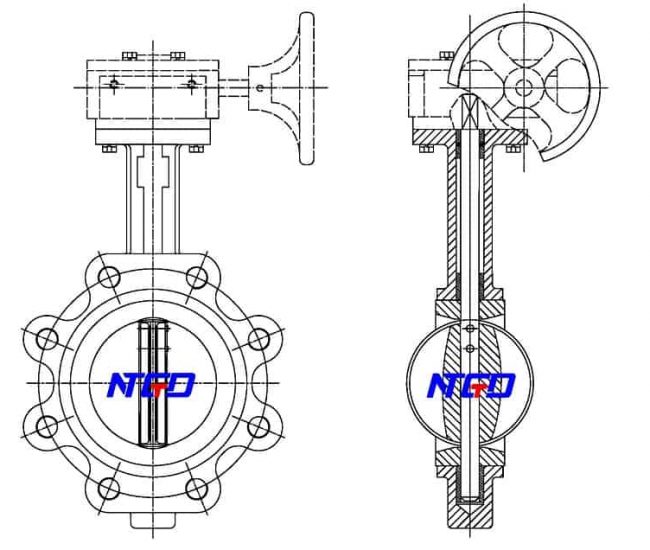
The shutoff in high-performance butterfly valves can be achieved by either an interference-fitted seat design or by using a line-energized seat design, in which the pressure in the pipeline is employed to enhance the interference between the seat and disc edge. Because of its wide range of compliance and thermal gradient, PTFE or reinforced PTFE (RTFE) is the most commonly used seat material.
High-performance butterfly valves are also available with metal seats. These metal seats enable a butterfly valve to operate at temperatures up to 1,000 degrees Fahrenheit. There are fire-safe designs available that facilitate the shutdown of a polymer seat valve well before the fire, and a metal seal backup offers shutoff during and after a fire.
Classification: Butterfly Valve
Butterfly valves are classified based on their disc closure design. The two common designs are named as:
- Concentric Butterfly Valves: These are standard butterfly valves that are mostly used for low-pressure water delivery and throttling services. The disc, shaft, and seats are all in the same plane. An interference fit is there between the disc and the resilient (elastic) lining which creates the seat. The valve’s working torque and the seal between the shaft and the liner restrict the seat’s tightness. This valve has weak sealing qualities and leakage problems.
- Eccentric Butterfly Valve: Eccentric Butterfly Valves are also named High-Performance Butterfly Valves, have a stem that does not pass through the disc’s central axis, but is offset from it and comes in the subcategories of double and triple offset eccentric valves.
The high-performance butterfly valve offers outstanding sealing and tight closing properties. Since the disc and seating of this valve are offset from the shaft, sealing of the shaft is not required. These valves are “fire-safe” because they feature a sturdy primary seat and a secondary metal-to-metal seal. These high performance valves are available in pressure ratings up to ANSI 900 and can be used in operational conditions that requires tight closure.
Features, Benefits & Limitations: Butterfly Valve
Butterfly valves come with a power-packed performance and they have an edge over other types of valves, though there are some areas where butterfly valves are unable to deliver at their best. Here we will discuss some features and limitations of butterfly valves.
Features:
- Compact in Size and Lightweight: Butterfly valves require less construction material & small installation area due to their compact design and shorter face to face dimensions and thus have decreased installation expenses such as labor cost, equipment, and they also require far less structural support than a ball valve of the same diameter which saves a lot of initial costs.
- Easy and Quick Operation Mechanism: As it is a quarter-turn valve a short movement of the handle, or the actuator, closes or opens the valve completely. Butterfly valves with a larger diameter, sometimes require a gearbox as part of the actuation device, which decreases operating torque and improves valve operation but at the cost of slower operation time.
- Less Maintenance: Butterfly valves are popular because of their basic, cost-effective design, which has few mechanical parts and hence fewer wearing points. This makes them robust and reduces their maintenance costs. Because of the reduced wear, the valve’s service life can be extended. This lowers the operating expenditures and minimizes the number of hours spent on valve maintenance.
- Versatile in Use: Butterfly valves are ideal for managing slurries or liquids containing large volumes of suspended material. It can transport mud with only a small amount of fluid deposits at the pipeline discharge.
- Low-Pressure Sealing: Butterfly valves provide strong sealing at lower pressure and are simple to open and close.
Limitations:
- Pressure Drop: Even when fully opened, a portion of the disc constantly faces the flow. Regardless of the setting, the functioning of a butterfly valve always results in a pressure drop over the valve.
- Poor Sealing: When butterfly valves are used in high-pressure systems their capability to seal goes down and are not able to seal properly.
- Cavitation: In butterfly valves, cavitation occurs during the last few angles of closing when the supply pressure is above 100 psi. Valves can resist short periods of cavitation, but when the valve is used to throttled or modulated in a cavitating environment for extended periods of time, the valve’s life is severely affected.
Top 4 Butterfly Valve Manufacturers
Company Name: Emerson
Type of Business: Butterfly Valve Manufacturer
Company’s Address: 8000 West Florissant Avenue, St. Louis, MO 63136, United States
Contact Information: +1 314 553 2000
Other Products: Control, Isolation, Solenoid, Relief Valves, etc.
Applications: Nuclear Plants, Subsea, Petroleum Industry, etc.
Company Name: KSB SE & Co. KGaA
Type of Business: Manufacturer
Company’s Address: Johann-Klein-Straße 9, 67227 Frankenthal, Germany.
Contact Information: Tel: +49 6233 86-0
Other Products: Power stations, buildings, ships, and in-process and water engineering systems.
Applications: The product range comprises globe valves, gate valves, butterfly valves, ball valves, diaphragm valves, and check valves, as well as actuators and positioners.
Company Name: Flowserve
Type of Business: Butterfly Valve Manufacturer
Company’s Address: Flowserve World Headquarters, 5215 N. O’Connor Blvd., Ste 700 Irving, TX 75039 USA
Contact Information: 972-443-6500
Other Products: Ball, Butterfly, Rotary & Linear Control, Gate, Globe, Plug Valve, etc.
Applications: Oil & Gas, Chemical, Power, Water, General Industries.
Company Name: Cameron: A Schlumberger Company
Type of Business: Manufacturer
Company’s Address: 5599 San Felipe St, Houston, TX 77056, United States
Contact Information: +971 4 274 2200
Other Products: Low Emission valve, Butterfly, Ball, Gate, Check, Plug / Diverter valves, etc.
Applications: Subsea, Drilling, Production, Gas & Liquid transmission, etc.
Summary
Butterfly valves are useful in pipelines because they assist in regulating fluid flow. They are capable of stopping or starting any fluid flow, as well as regulating the rate of flow. Some butterfly valves are better for corrosive systems, while others are better for high-pressure fluids.
Thank you for taking the time to read this article; please contact us if you have any questions about our many varieties of butterfly valves or any of our other products.

